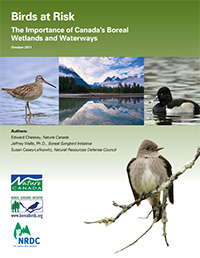Announcements
Press Release: International Conservation Groups Urge Action to Save Canada's Freshwater
Experts Note Boreal Water Critical to Billions of Birds
October 26, 2011 (Ottawa) - As billions of birds near the end of their annual fall migration from Canada, international experts are calling for increased protection of Canada's "bird nursery of the north": the water-rich boreal forest which contains the breeding and nesting grounds for billions of migratory birds and whose waterways and wetlands are under increasing pressure from the double threat of industrial expansion and climate change.
In a report released today entitled Birds at Risk: The Importance of Canada's Boreal Wetlands and Waterways, a coalition of conservation organizations have called upon Canadian governments to seize on the many opportunities to save intact boreal landscapes—the largest source of global freshwater—while there's still time.
"Just as we depend on the natural resources of the boreal, so do billions of birds who nest, breed and stop over there," said Ted Cheskey, Nature Canada's manager of bird conservation and a co-author of the report. "These vital waterways and wetlands are under increasing threats posed by industry such as tar sands, mining, logging and hydropower. This is, of course, compounded by the effects of climate change."
"Canada's boreal is the largest intact forest left on earth," said Susan Casey-Lefkowitz, international program director at the Natural Resources Defense Council. "Yet only a fraction of this landscape is protected, far less than is scientifically recognized as necessary to sustain the ecosystem over time.
"Thankfully, we still have the potential to make a unique contribution to conserving international migratory birds through preservation of the boreal. Governments should act quickly, using the best science available, to create a healthy future for the boreal and the migratory birds who call it home."
The report was issued by Nature Canada, Nature Quebec, the Boreal Songbird Initiative, and the Natural Resources Defense Council and focuses on three boreal areas that are critical for birds:
• The Hudson and James Bay Lowlands, where hydroelectric projects in the Hudson and James Bay Lowlands have flooded a huge swath of boreal forest, removing prime breeding habitat for as many as 10 million birds, including the Surf Scoter.
• The Peace-Athabasca Delta, where a dam and tar sands operations are reducing flows, and threatening water quality.
• The Lake Superior Watershed, where logging is reducing the diversity of plant and animal species and threatens food supplies and aquatic habitat.
The report also notes that the boreal waterways, peatlands and wetlands are important to some of the most threatened bird species, including the Rusty Blackbird which breeds across the boreal and always nests near water. The Rusty Blackbird has experienced a more than 90 percent population decline since the 1960s and is listed under Canada's Species at Risk Act as a species of "Special Concern."
"For some very vulnerable species of boreal birds," said Jeff Wells, Boreal Songbird Initiative's Science and Policy Director, "Canada's boreal forest is their last haven and their best hope for survival. We can't take it for granted that the boreal will always remain an intact landscape with abundant resources. Action should be taken now to safeguard the boreal for our benefit and the benefit of our shared global resources."
"As many as five billion birds flood south from the Canadian boreal to wintering grounds in the US, Mexico, and beyond. Canadians have an international responsibility to protect these breeding grounds as reflected in Canadian laws and international agreements," Cheskey said. "Protecting the boreal from the threats of development also protects indigenous communities across the boreal, where many people still live very close to the land. We strongly urge all governments in Canada to work with First Nations and others on a secure future for wildlife and birds by protecting at least 50% of the boreal forest."
For more information, contact:
Ted Cheskey, Manager of Bird Conservation
Nature Canada
Tel: (613) 562-3447 ext. 227
Cell: (613) 620-5324
tcheskey@naturecanada.ca
Blog: www.naturecanadablog.blogspot.com
Susan Casey-Lefkowitz, Director, International Program
Natural Resources Defense Council
Tel: (202) 289-2366
Cell: (646) 287-6225
email: sclefkowitz@nrdc.org
Blog: http://switchboard.nrdc.org/blogs/sclefkowitz/
Jeff Wells, Ph.D., Science and Policy Director
Boreal Songbird Initiative
Tel: (207) 458-8492
jeffwells@borealbirds.org
Blog: http://www.borealbirds.org/blog/
Backgrounder: Boreal by the numbers
• Canada's boreal forest represents 25% of the world's remaining intact forest.
• The boreal contains the world's highest concentrations of large wetlands, lakes, and undammed rivers. There are more than 800,000 square kilometers of surface fresh water within its borders.
• Over 300 species breed in the boreal.
• Of these, 40 land birds and several duck species are facing declines. Habitat loss is one likely cause.
• 80% of North American waterfowl, 63% of finches, and 53% of warblers breed in Canada's boreal forest.
• For at least 96 species, over half of their entire breeding population occurs in the boreal.
• Many boreal bird species have registered serious declines in recent years. Rusty Blackbirds have declined by 90%, Boreal Chickadees and Evening Grosbeaks by more than 70%, Olive-sided Flycatchers, Bay-breasted and Canada Warblers by over 50% as have the boreal-breeding ducks Surf Scoters and Scaup.
• Boreal birds are serious economic drivers. Boreal birds conduct over 5 billion dollars worth of ecological services by pollinating plants and controlling insect pests.
• 60 million people spend time in North America watching migratory birds and 3.2 million people hunt ducks and geese every year spending tens of billions of dollars annually on travel, lodging and gear.


